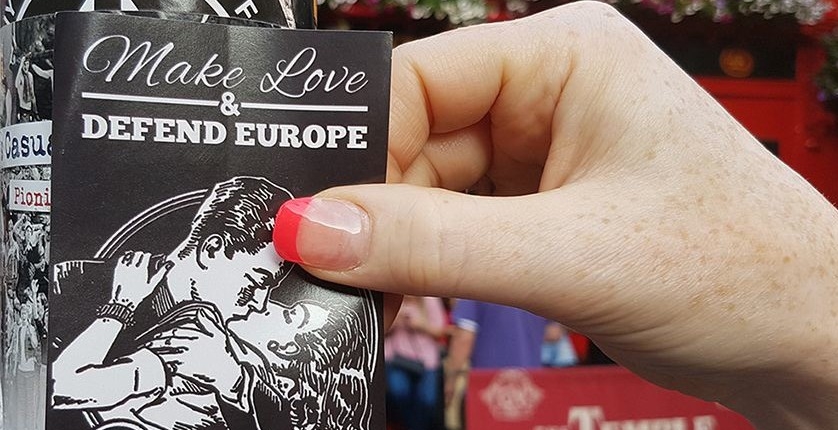Identitarianism in Europe versus the United States
Generation Identity using stickers to display its message on the streets of Europe
This article was self-published, October 7, 2017.
Identitarianism in the West is growing. The group leading European identitarianism is Generation Identity: a youth-based pan-European movement currently active in Germany, Austria, France, Italy and the United Kingdom and Northern Ireland. The group leading American identitarianism is the Alt-Right, a loosely defined movement mainly lead by white nationalists. European identitarians made headlines when they rented a C-star boat to stop NGOs transporting migrants rescued in the Mediterranean to Europe. Mainstream outlets like Vice, The New York Times, and Vox covered the story by defining Generation Identity as being “Europe’s Alt-Right”. Many American white nationalist figures, including Richard Spencer, have shown their support for the movement. The Spartan flag, the main symbol of Generation Identity in Europe, was seen at the Charlottesville rally, and was adopted by other American white advocates. Despite Generation Identity’s website stating it denies platforms to both fascists and national socialists, and stays “out of conflicts outside of Europe”, these movements share important fights: ending politically correct orthodoxy, halting mass immigration, and defending European identity. It is not surprising then how the media has amalgamated both streams of identitarianism, especially when American Alt-Right groups like Identity Evropa use almost identical self-definitions as those of Generation Identity in Europe. And so the differences in these streams of identitarianism have been overlooked.
Spartan symbol from Generation Identity in Europe seen at the Charlottesville Unite the Right rally
White nationalism
“We are not white nationalists,” said the head of Generation Identity in Italy, Lorenzo Fiato. Here we find the first rupture between these two movements. While Generation Identity opposes anti-white racism, it also rejects white nationalism. The concept of white identity doesn’t garner much appeal in Europe, particularly in continental Europe. The first reason for this difference is due to historical demographics. White-race identity became prominent in America from the African slave trade. The juxtaposition between blacks and whites in relation to the drastically different roles these two groups held in society created a strong sense of race-identity, which has persisted in the abolitionist period, the civil rights era, all the way to the modern day. Concepts like “white privilege” and “white supremacy” are ubiquitous in American academia, media, and popular culture. In contrast, these concepts are almost entirely absent from European public discourse. Despite modern European colonialism in Africa, slaves were never imported into Europe, and no contrast between the white and black race took place as a result. There was a difference between Europeans who settled in Africa, and those who remained in Europe never seeing a black face. Europe has historically been a more homogeneous continent, making white-race identity an unnecessary concept. Even at the peak of European — or German — racism, during the Holocaust, racial aspects of identity were defined in terms of Aryanism, rather than whiteness, as many non-Orthodox Jews are aesthetically inter-changeable with what we now understand to be “Whites” (and there are on-going debates on whether Jews classify as being White for this reason).
While the same peoples have lived in Europe since the dawn of its civilisation, thereby making its composition more racially homogeneous, Europe is also far more ethnically heterogeneous in terms of its internal demographics. The United States was comprised predominantly by Anglo-Saxons, while Europe includes Mediterraneans, Slavs, Germanics, and Nordics. Each ethnic group has played a role in shaping European identity. Theories of white-race identity can be exclusive, particularly in the south of Europe. Italians, Spaniards and Greeks are composed by many Mediterraneans, as were the ancient civilisations of the Greeks and the Romans. Aesthetically speaking, Mediterraneans often look alike to Middle Easterners and North Africans — during the Roman Empire, they shared a civilisation, while the Celtic and Germanic tribes were considered barbarian enemies. Even the Nazis conceded the achievements of the Mediterranean race posed a problem to their concept of Nordic-Germanic Aryanism. Richard Spencer seemed to have acknowledged the limitations of identifying his ideology in terms of white-identity when he said southern dark-eyed, dark-haired, and dark-skinned Italians are more European than blonde and blue-eyed Middle Easterners, and as a result, whiteness meant “a culture” rather than a racial aesthetic.
The United States has also been at the epicenter of multi-culturalism since the 1970s, when aboriginals, Latinos, and African-Americans began to affirm their own identity, and European-Americans became a melting pot from diverse ethnic European groups, including the Germans, the Irish, and the Italians. The concept of multi-culturalism was only recently introduced in Europe, as Europe (in contrast to America) has always been the homeland of Europeans. Even with its own cultures, Europe never became a melting pot. The European Union has tried to erase national differences, albeit unsuccessfully.
European-Americans have largely stressed the role of race in defining culture. While Generation Identity argues ethnic identity is paramount, it also views it as a more dynamic aspect of one’s identity. For them, defining identity on purely racially aesthetic grounds can be myopic, as Europe is shaped and defined by a diverse ethnic history.
The Jewish Question
White nationalists see Jewish influence as a sinister force seeking to delegitimise European traditional value-systems. This is why Alt-Righters have been defined by much of the media as being outright neo-Nazis. American white-nationalists believe Jews are either Zionists promoting the existence of the Jewish state of Israel, or “cultural Marxists” promoting “degeneracy” and “immorality” in European countries. Cultural Marxism has become an ambiguous, albeit now mainstream term within both the Alt-Right and the New-Right, and it generally refers to the the Frankfurt School, an intellectual movement which after the failure of 20th century communism, sought to bring the Marxist revolution by tearing down cultural super-structures in art, academia, and the media. Not everyone in the New-Right who uses the term cultural Marxism believes in the Jewish conspiracy, but for American white nationalists, Jews are the architects of European decadence as well as their following demographic replacement.
“I don’t believe the Jewish conspiracy theory — I find it a very short-sighted,” said Fiato. He pointed out how Europeans are themselves celebrating their own replacement. Even some of the most influential “cultural Marxist” or post-modernist thinkers were European; Antonio Gramsci, Michel Foucault, and Albert Camus were all non-Jewish. Lorenzo thinks Jewish lobbies in America naturally seek to protect Israel’s national interests, but this does not imply that such interests are incompatible with Western countries. Indeed, Fiato believes European Jews are among the primary targets of Islamists in Europe. While Generation Identity believes Jewish identity is distinct from European identity, it views the issue from a more nuanced perspective. Jews and Europeans have mixed for centuries, and many Europeans with Jewish ancestry feel no connection to the Jewish aspect of their identity. For European identitarians, Islamic lobbies represent one of the greatest foreign threats to Europe’s survival, as their influence in liberal media, universities, and think tanks has, in their eyes, promoted acquiescence to the “islamisation” of Europe. “Judaism is not like Islam; Islam is a religion which by nature imposes and spreads itself through colonisation and conversion; Islam has caused problems in every country where is has set foot,” Fiato said.
Ironically, even self-declared fascist groups (a definition many Alt-Right figures have repudiated) like CasaPound in Italy reject racial separatism, and argue Benito Mussolini’s alliance with Adolph Hitler, and the subsequent introduction of racial laws, were among his biggest mistakes. They point out how Italian Jews contributed in making the fascist party rise to power. Even Mussolini’s lover, Margherita Sarfatti — a prominent art critic, patron and journalist — was Jewish. Furthermore, CasaPound claims its fascism is non-racist by pointing out how the fascist hymn, “Little Black Face”, was inspired by a young Abyssinian girl found by Italian troops at the beginning of the Italian invasion of Ethiopia. The hymn narrates how the black girl was taken to Rome to be offered a dignified life. While fascism was a totalitarian ideology, the concept of racial separatism did not exist in the founding phases of fascist Italy. This was largely due to the more diverse racial composition of Italy compared to Germany; Italy is composed by Normans, Germanics and Mediterraneans, while Germany has been largely defined by Germanic tribes. Racial laws in fascist Italy were introduced later at the bequest of Hitler, when Mussolini decided to bow to German pressure with the Manifesto of Race in 1938, separating ethnic Italians (with their variations) from Jews and Africans.
CasaPound using imagery of Mussolini in Naples headquarters
On women
Both Generation Identity and the Alt-Right argue third-wave feminism undermines the harmony that has defined traditional gender-relationships until the sexual revolutions of the ‘68ers. Female European identitarians created their own platform in Europe, where they promote women’s activism in defending European identity within some of the traditional spectrums of women’s role in society. But Generation Identity is also far less reactionary; it rejects the kind of dark-age gender-traditionalism promoted by much of the Alt-Right. American white nationalists often move to the extreme side of the reactionary spectrum in response to the more prominent role that deconstructionist theory has had in American culture, particularly through popular culture, which has largely replaced high-culture in American life. Despite how post-modernist thought was mainly born out of continental Europe, popular culture, or the celebrity cult, has had a far less significant role in replacing European high-culture.
Generation Identity believes women can and should play more prominent roles in public life. It stresses women’s role in the growth of right-wing parties in Europe like the National Front and Alternative for Germany. “We need a larger female presence in our movement,” Fiato said. They believe women have various ways of expressing their femininity, and they should not be seen as having a singular role in society.
Female identitarians in Europe do martial arts training during Generation Identity’s summer camps
In contrast, American white nationalists claim that a woman’s role lies almost exclusively as homemakers and chid-bearers. “It’s a monolithic view of women,” Lorenzo said. “Sure, women’s family role has been undermined by competitiveness with men in the work-force, but this does not mean that women should be confined to the home.” American white identitarians have also taken their views on women to social media by creating “thot patrols”— where they monitor the behaviour of women they see as degenerate. European identitarians believe the sexual revolution has damaged women’s well-being, but they also don’t shame women who adopt alternative lifestyles. This brings us to the last, and perhaps the most important difference.
Approaches
The Alt-Right’s ideology was popularised from the internet with provocative memes, anonymous platforms like 4chan and Reddit, and social media accounts. It used a sub-culture as a way to break the dominating consensus surrounding issues from feminism, racism, to sexuality. In contrast, Generation Identity is largely an off-line movement based on training, educating, and activating European youth into affirming their identity.
“Everything that takes place online is very useful, but while online provocation is important, it shouldn’t be an end in itself — trolling is useless,” Fiato said. The leaders of these movements recruit and display their ideas in radically different ways; the Alt-Right is based in the virtual world, with independent YouTube channels and commentary websites, Generation Identity is based in the real world by displaying banners, organising summer training camps, and actively defending Europe’s borders. Generation Identity also tends to have more open confrontations with their ideological opponents; they are interviewed on national television and prominent media outlets, while white nationalists largely operate within their own sphere, as they have been largely rejected by, or have themselves rejected mainstream outlets.
European identitarians are an organised, well-defined group, whereas American identitarians are de-centralised, and with so many shades to their ideology they are often hard to define in a singular way. The different organisational structures between these two movements show particularly when they organise public rallies. The American Alt-Right uses a range of symbols from memes like Kek and Pepe the frog, confederate flags (although not all those who use the confederate flag are necessarily white nationalists — some use it as a cultural symbol), to strong fascist-resonating symbols like the Celtic cross, reflecting the more confused nature of the movement. In contrast, European identitarians use the Spartan symbol to show they are a unified movement with a clear message.
Alt-Right vs Generation Identity rallies
“Overall, I think our movements might be more related as cousins, rather than brothers,” Fiato concluded.







